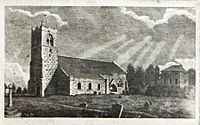St Mary's Church, Blymhill facts for kids
Quick facts for kids St Mary's Church, Blymhill |
|
|---|---|

A view of St. Mary's Church in Blymhill from the north.
|
|
| Religion | |
| Affiliation | Anglican |
| District | Diocese of Lichfield |
| Ecclesiastical or organizational status | Parish church |
| Leadership | Linda Beech, Curate |
| Location | |
| Location | Blymhill, Staffordshire, England |
| Architecture | |
| Architect(s) | George Edmund Street |
| Architectural type | Church |
| Completed | 1859 |
| Materials | Sandstone |
St. Mary's Church is an Anglican church located in the small village of Blymhill, Staffordshire, in England. This historic church is a Grade I listed building, which means it is considered a building of exceptional national importance and must be protected.
The church was first built in the 14th century. Over the years, it has been restored and added to. It showcases different styles of Gothic architecture, including an Early English style south aisle, a Decorated Gothic style chancel (the area around the altar), and a Perpendicular Gothic style tower.
Contents
History of the Church
Early Beginnings
A church has stood in Blymhill for a very long time. Before the 11th century, it was a smaller church, known as a chapel of ease, connected to a larger church in Gnosall. This meant local people could worship here instead of traveling to the main church.
Around the year 1200, Blymhill became its own parish with its own priest, called a rector. The family who owned the land, the Bagots, gained the right to choose the rector. A complete list of all the rectors from that time still exists today.
The church you see now was built in the mid-1300s, probably while Stephen de Bromley was the rector. It is believed that a weathered stone coffin in a nook on the outside of the church wall belongs to him, as this was often where a church's founder was buried.
Major Changes and Restoration
Around 1719, the church was updated. The pointed Gothic windows were replaced with large, fashionable round-headed windows. However, during a major restoration in 1858–59, the old Gothic style was brought back. This work was led by the architect George Edmund Street.
During this restoration, many changes were made. According to the official plans, the builders were allowed to:
- Take down a gallery at the west end of the church.
- Remove the north wall to make the church wider.
- Add a new aisle on the north side.
- Close the old entrance through the tower.
- Build a new porch on the north side.
- Put new roofs on the entire church.
New oak pews, a pulpit, and a font were also added. After all this work, the inside of the church was too dark. To fix this, two new windows were added to the south wall in 1861. Then, in 1876, special windows called dormer windows were built into the roof of the south aisle to let in even more light. This is unusual for a church.
In 1936, a new chapel was added to the church. It was named St. Chad's Chapel. St. Chad was a saint from the 7th century who is said to have preached near Blymhill.
Famous People at the Church
An "incumbent" is the priest in charge of a church. Two notable incumbents at St. Mary's were:
- Samuel Dickenson (1777–1823) – He was a botanist, which is a scientist who studies plants.
- George Thomas Orlando Bridgeman (1853–1865) – He was an antiquary, someone who studies history through old objects, buildings, and records.
See also
- List of Grade I listed buildings in Staffordshire
- Grade I listed churches in Staffordshire
- Listed buildings in Blymhill and Weston-under-Lizard


